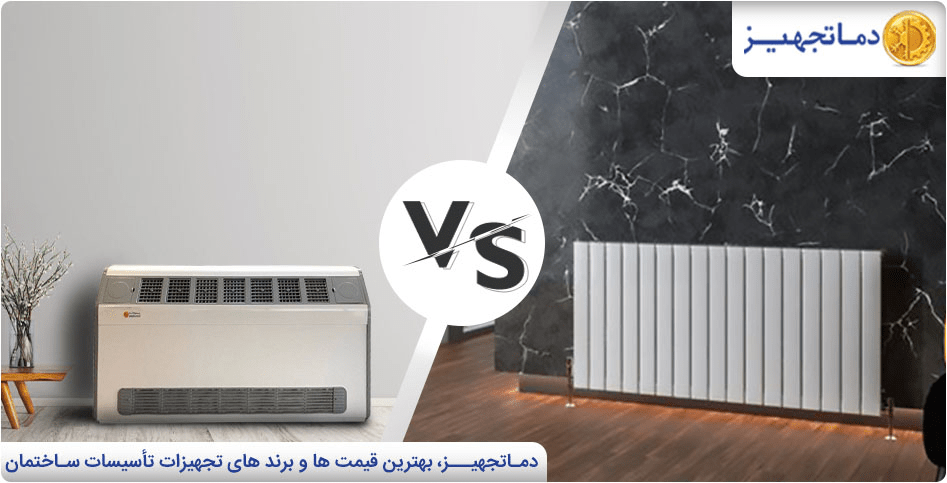Among the questions that occupy the minds of some users and employers when choosing and buying heating equipment, is a question about whether a fan coil is better or a radiator. To answer this question, it is necessary to examine the differences between these devices. Stay with us.

Comparison of fan coil with radiator
In order to answer the question, is fan coil or radiator better, we can use fan coil and radiator together from different perspectives. Fan coils and radiators are two types of heating and cooling equipment that are used in a wide range of commercial, residential, etc. buildings. The fan coil is actually a means of transferring heat or cold from water to air with a forced ventilation fan for environments even with a high ceiling height, and its minimum components include a coil, motor, distillation tray, and air blower fan, which must be cold water. To cool it through the refrigeration system of the building.
On the other hand, radiators are widely used heating equipment to provide heat in spaces with a ceiling height of about 3 meters. In simple words, radiators are heat exchangers (water to air) that transfer the required energy through the central heating system of the building or the heating package in each unit with the aim of limited heating of the environment.
In the following, we will examine and compare the difference between fan coil and radiator from 7 different points of view, which is as follows:
- Ambient heating and cooling
- Air humidity control
- How to control the device
- Performance speed
- device power
- Device installation position
- energy consumption
- Ambient heating and cooling
Radiators are used only for heating the environment. In this way, the spa enters its pipes and then during the heat transfer process, they heat the air naturally (without using a fan). Therefore, in the summer season, separate cooling equipment should be used for the environment.
But fan coils are used for both heating and cooling. In this way, for cooling in the hot seasons of the year, the cold water of the chiller system, and for heating in the cold seasons, the hot water of the heating system enters the coil. In any case, in ceiling, ground, wall or channel fan coils, the air is forced (by a fan) through the coils and the air temperature decreases or increases.
Therefore, the fan coil device is dual-purpose (cooling and heating) and can be used in all seasons of the year, but if a radiator is used for heating, it is necessary to use another device for cooling.
Air humidity control
Since the fan coils are capable of cooling in the summers and hot seasons of the year by using the cold water of the chiller system of the building, and due to the contact of the air with the pipes containing cold water, as the ambient temperature decreases, the humidity also decreases. But since radiators are only a heating device, they are not able to change the humidity level of the air.
How to control the device
In radiators, the hot water flow is usually done through the radiator valve and manually and sometimes with the radiator thermostatic valve. This is despite the fact that the fan coils have both manual and digital control systems at the same time. By installing a thermostat in the fan coil installation location, it is possible to set the desired ambient temperature for the user in different seasons of the year. So fan coil or radiator are not the same in terms of device control.
Therefore, in buildings that require digital control and its connection to BMS, it is better to use a fan coil instead of a radiator.
Performance speed
In response to the question of fan coil or radiator, it is necessary to know the speed of operation of both devices. Due to the use of an aeration fan in the fan coil device, the heat exchange of this device with the ambient air takes place at a faster rate than the radiator. But because radiators do not have any kind of blower, they exchange heat slowly with the air and it takes more time for the air inside to heat up.
Therefore, the heating and cooling process is done by fan coils at a higher speed and in a shorter period of time.
device power
Because fan coils have a high-speed centrifugal ventilation fan and finned coils, and radiators do not have this possibility, so it must be said that the power of fan coils is even greater for heating than radiators. And for this reason, heating radiators can only be used for heating environments that have a ceiling height of less than 3 meters. Also, in cases where the existing radiator does not have enough heating power, if the hot water pipes of the radiator are removed from the floor of the unit (not from the wall), you can heat several times more than a 10-blade radiator block by installing a 200CFM ground fan coil. Find the desired space.
Device installation position
Another difference between radiator and fan coil is the installation location of these two devices. Radiators are often in the form of ground, but fan coils are designed, manufactured and installed in ceiling, wall, ceiling, ground, hidden and visible (exposed or not) types. The types of wall, ceiling or lack thereof, do not occupy any useful space of the surface area of halls or rooms.
Based on this, users can choose the right model of fan coils according to the available and usable space, but in case of using radiators, there is a limitation in the installation location. Therefore, in places where the device should not be installed on the floor, the best option is to use a ceiling, wall or ceiling fan coil instead of a radiator.
Damatajhiz; The best prices and brands of building installation equipment
final word
In this article, we tried to answer the question of whether fan coil or radiator is better. In this regard, we reviewed and compared these two devices and we hope that we have provided useful information. In some projects and according to the existing needs, fan coils may be used instead of radiators or any other system or vice versa. Therefore, you can visit the website of Dematahheiz specialized collection (the first and most reliable specialized collection in the field of building facilities equipment and all devices) to view and compare different types of radiators and fan coils with different brands and capacities, as well as to know the updated price of the products. Air conditioning since 2013 and having 3 valid business licenses. Also, to get more information and get advice, you can contact the experts of the heating equipment during office hours.
Looking forward to calling and to meet you in the Specialized Collection of Damatajhiz
By sharing the above article on social networks, let your friends know about its important content.


